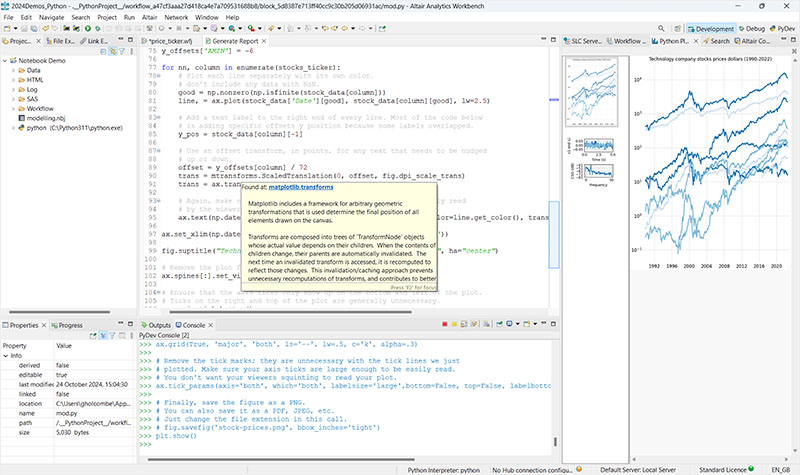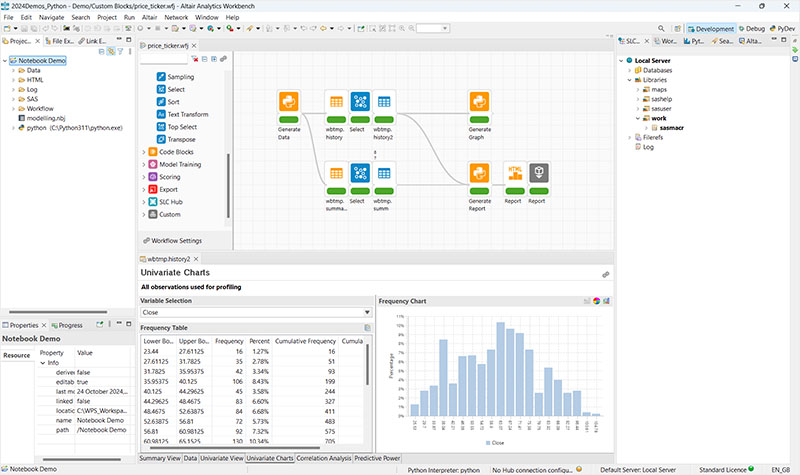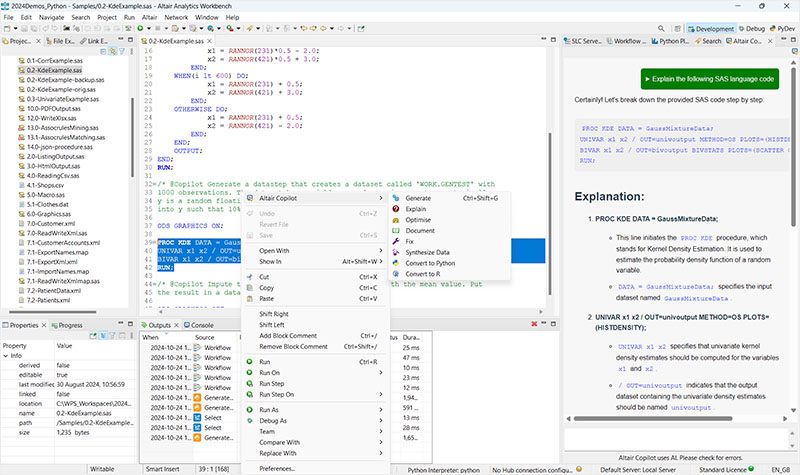Simplifying SAS to Python Migration with Altair’s Hybrid Analytics Platform
Upskilling: Getting the Right Technology into the Hands of Your Team
Effective use of data is emerging as a critical competitive advantage in a business landscape where technology is evolving quickly. To remain relevant, companies must navigate a constant wave of new tools, systems, and vendors, selecting the best to power their business. Good technology choice—considering factors like performance, usability, cost, talent pool—can define an organization's success. Poor technology choice will see the competition move ahead.
Traditional tools and technologies such as the SAS language, coding integrated development environments (IDEs), and on-premises servers and databases are seeing an influx of emerging technologies like Python, AI-powered user interfaces, and cloud-based compute and data repositories like Snowflake, BigQuery, and S3. While this transition opens the door to innovation, it presents challenges for organizations with deep-rooted legacy infrastructure.
Organizations with a history of using the SAS language, for instance, often find themselves at a crossroads. Unlike newer businesses that may select latest technologies from the outset, older, bigger organizations must balance cost, operational risk, re-training, and resistance to change with the desire to modernize.
Challenges of Rewriting SAS Language Applications
Organizations making extensive use of the SAS language face two modernization options:
- One-Time Complete Migration: Replace the entire SAS language infrastructure with alternative technologies in one go, the so called “big bang” approach. While in line with strategy, this process is expensive, time-consuming, and risky. Downtime, disruptions, and misalignment between old and new systems are obvious risks, and benefits of replacement technologies are not always proven or clear-cut. The prospect of project failure is high resulting in no strategic progress.
- Staged or Partial Migration: Gradually update, replacing applications, systems, and components one-by-one. While the risk of large-scale operational disruption is reduced, this approach may cost more overall and can create compatibility and interface issues between existing and replacement systems throughout a multi-year program of work. However, even if the program of work is paused or terminated early, strategic progress may be made. At all times there will still be a need to license a SAS language compiler if and until all SAS language components have been rewritten.
Both paths pose significant challenges making it difficult for organizations to move and adapt to stay competitive. Altair can help address these challenges.
Altair’s Low-Risk Approach to Modernization
Altair can help organisations choosing the second option above offering a transformative yet low risk approach for organizations that depend on SAS language environments for critical business processes. Altair’s approach allows organizations to modernize incrementally while minimizing cost and disruption and opening clear avenues to new technologies.
By creating a hybrid ecosystem that integrates the SAS language, Python, and R, Altair ensures teams can retain key infrastructure while adopting modern technologies at a pace that suits an organization and its people and with controlled ongoing cost. This strategy minimizes operational risk resulting from change and enables organizations to upskill their workforce, fostering a culture of continuous learning and innovation. Upskilling includes both introducing existing staff to new technologies (e.g. upskilling SAS language programmers in Python) and introducing new staff to existing system technologies (e.g. upskilling new Python programmers in the SAS language).
A Look at Altair Analytics Workbench
Altair Analytics Workbench®, a key part of the solution, provides a centralized tool for data preparation, analysis, and visualization using multiple data languages. Key features include:
- Dynamic Dashboards for monitoring workflows
- Interactive Data Visualization tools for insights across both SAS language and Python datasets
- Integration with Cloud and On-Premises Systems, ensuring flexibility for any organization
Key Features of Altair’s Approach
- Seamless Python Integration
Altair enables SAS language programmers to learn Python within a familiar user interface, bridging the gap between traditional SAS language expertise and Python-based applications. Simultaneously, new Python developers can use and contribute to SAS language applications without needing extensive training on legacy systems. - Visual No-Code Tools
Non-technical users can participate in data analytics through intuitive, no-code tools. These tools allow users to blend Python and SAS language code to perform complex tasks, including building data processes, SQL queries and predictive models, without requiring extensive programming skills. - Notebook-Style Hybrid Interface
Altair offers a variety of productivity tools including a flexible interface inspired by Jupyter notebook-style interaction. This desktop environment combines the best of both worlds, enabling teams to work seamlessly with the SAS language and Python while benefiting from a modern, rich, user-friendly experience. - AI-Powered Assistance
Altair's tools incorporate industry-leading AI-powered assistance including copilot features to accelerate skill development. Whether it is writing accurate code or troubleshooting errors, these features reduce training time and improve productivity for both SAS language and Python programmers.




While there is some support above for the R language, full support for R is planned in future.
Upskilling, and Cross-skilling: Workforce Development
One of the greatest benefits of Altair’s approach is the focus on workforce development. Transitioning from pure SAS language to a hybrid SAS-Python environment requires more than just adopting new tools—it necessitates a strategy for building team capabilities. Altair supports this process through:
- Upskilling: Easy cross-training existing SAS language programmers to adopt Python within a familiar, combined environment. Equipping new Python developers with the knowledge and tools to work with existing SAS language applications with minimum difficulty.
- Cross-skilling: Empowering non-technical users to use no-code tools, enabling broader participation in data analytics tasks.
These strategies ensure that every team member—regardless of technical expertise—can contribute effectively to an organization’s strategic technology goals.
Real-World Applications and Benefits
Altair’s low-risk modernization framework is already driving significant value for organizations across industries:
- Accelerated Project Timelines: By eliminating the need for a complete one-time rewrite, teams can focus on delivering value faster.
- Cost Savings: Cost-effective hybrid systems streamline change by minimizing duplication and enabling organizations to maximize staff utilization.
- Enhanced Collaboration: Cross-technology tools bring diverse teams together, fostering collaboration between existing and new teams and staff.
For example, a leading financial services provider worked with Altair to migrate certain processes to Python while retaining SAS language components essential for regulatory compliance. This approach reduced ongoing costs significantly while improving team efficiency and introducing new technology at low risk and low cost.
Conclusion: A Strategic Path Forward
Modernizing a SAS language environment is more than just a technology shift—it’s about managing risk, maximizing benefit and controlling cost whilst staying aligned with long-term strategy. Altair’s balanced approach minimizes risks of transitioning towards new technologies while maximizing workforce potential through easy upskilling.
By blending the best of the SAS language and Python within a flexible, AI-enabled environment, Altair helps organizations to embrace the future of data analytics without wasting past investment and intellectual property. Whether it’s improving team productivity, reducing costs, or accelerating innovation, Altair delivers the tools and strategies needed to succeed in a rapidly evolving technological landscape.
To learn more about how Altair can help transform your data analytics journey, visit altair.com/altair-slc.




